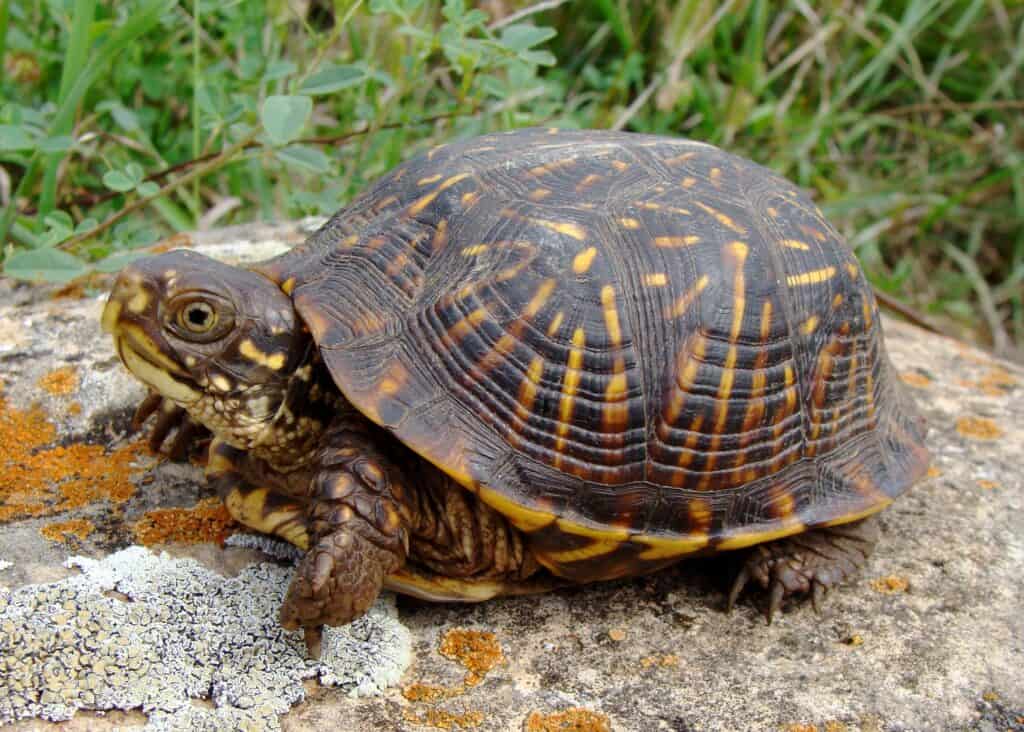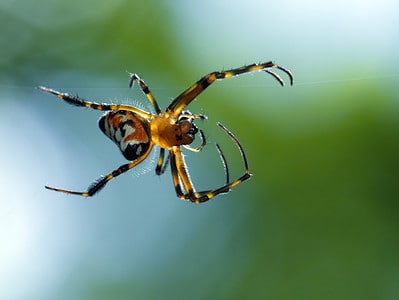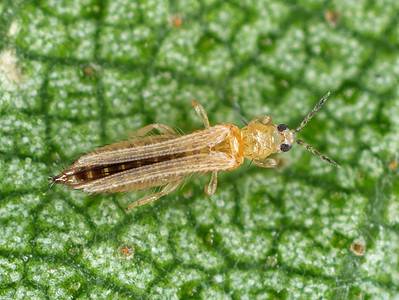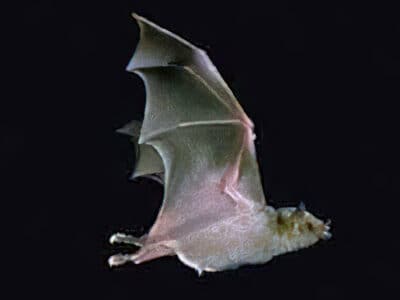Ornate Box Turtle
Terrapene Ornata
One of the biggest threats to the orate box turtle population is that when during extremely hot or cold breeding season a vast majority of the hatchlings are of one sex.
Advertisement
Ornate Box Turtle Scientific Classification
- Kingdom
- Animalia
- Phylum
- Chordata
- Class
- Reptilia
- Order
- Testudines
- Family
- Emydidae
- Genus
- Terrapene
- Scientific Name
- Terrapene Ornata
Read our Complete Guide to Classification of Animals.
Ornate Box Turtle Conservation Status
Ornate Box Turtle Facts
- Prey
- Insects
- Name Of Young
- Hatchlings
- Group Behavior
- Solitary
- Fun Fact
- One of the biggest threats to the orate box turtle population is that when during extremely hot or cold breeding season a vast majority of the hatchlings are of one sex.
- Biggest Threat
- Urbanization and enviornmental threats
- Most Distinctive Feature
- Beautiful design of shell
- Incubation Period
- 3 months
- Litter Size
- 3-8
- Habitat
- plains and grasslands
- Diet
- Omnivore
- Lifestyle
- terrestrial
- Location
- USA
- Group
- Bale
- Nesting Location
- sandy holes in the ground
View all of the Ornate Box Turtle images!
“Ornate box turtles can live up to 40 years in the wild!”
Ornate Box Turtle Summary
The ornate box turtle is one of two commonly found land turtles in the plains of the USA. The animal is the state reptile of Nebraska and Kansas and is commonly found in the grasslands in both states. Unlike most turtle species, they are land based and live mostly out of water.
5 Incredible Ornate Box Turtle Facts
- The ornate box turtle has a hinge in its shell. This means that even when they stick their legs, tail, and head out, they can still be sheltered by the shell, keeping them safe from predators.
- These turtles usually live alone for life, only interacting with other turtles to breed.
- They are often mistaken for a subspecies called the T. O. Luteola. The only difference between the two is that the T.O. Luteola has brighter colors and more yellow stripes than the ornate box turtle.
- This turtle is the official reptile of the state of Kansas. This means that it is illegal to hunt or catch them there.
- Although they primarily inhabit the plains and stay away from water bodies, if they do somehow end up in the water, fat deposits under their shells allow them to swim and float remarkably well.
Scientific Name
The ornate box turtle’s scientific name is Terrapene ornata. It belongs to a family of turtles known as box turtles. Zoologist Blasius Merrem coined the name of their genus Terrapene in 1820 to separate them from the Emys genus. Ornata refers to the ornate patterns on their shell.
Ornate Box Turtle Appearance
It is a relatively small turtle, about 4 to 6 inches, when fully grown. That is about as long as your credit card. They have two shells, an upper and a lower one, that are connected around the head and legs. The turtles also have four toes on each leg.
The main distinguishing feature of ornate box turtles is the colorful design of their shells. The shell design is yellow, black, and red with a striped pattern.
The male ornates are typically smaller than the females. The males have larger inner claws on their back feet and a longer, thicker tail. They also have a red eye color, unlike the females, which have brown eyes.

The main distinguishing feature of ornate box turtles is the colorful design of their shells.
©Matt Jeppson/Shutterstock.com
Ornate Box Turtle Behavior
They are very shy animals that prefer to live on their own. Their wild counterparts are more aggressive than those in captivity. When threatened, they will retract all of their limbs and head into their shell to protect themselves. They feel threatened very easily, so it’s advisable to approach them calmly.
Ornate box turtles hibernate in burrows in the winter and only come out in the summer. They are cold-blooded, so they hide out during extreme temperatures to keep their body temperature regulated. The ideal temperature for these animals is around 80 to 88 degrees Fahrenheit during the day and around 70 to 75 degrees at night.
Ornate Box Turtle Habitat
They are most commonly found in grasslands in the USA. This turtle has three requirements for an ideal habitat:
- Grassy land with some water for them to feed on
- Soil for burrows to hide in the winter or for females to nest
- Resting sites under trees to regulate their body temperature in case it gets too hot
Like all other reptiles, ornate box turtles are ectothermic (cold-blooded), so the temperature of their environment regulates their body temperature. If the temperature is too hot, they are less active and try to cool down. Shrubs play a key role in shading them when it’s too hot. And burrows help them keep warm if the weather is too cold.
In the winter, they burrow into the ground and come out once the weather is more suitable. Hibernation begins in October and lasts until April, when spring begins. These burrows are roughly 5 to 20 inches deep.
Ornate box turtles have a high degree of philopatry, which means that they return to their habitat once the winter’s over. Thus, once they inhabit an area, they usually don’t leave it.
Ornate Box Turtle Diet
These turtles are omnivores whose diet consists of grass, shrubs, alongside insects, grasshoppers, and caterpillars as their protein source.
What Does It Eat?
As mentioned above, the ornate box turtle’s diet consists of both plants and smaller animals. They don’t have any food preferences, meaning they eat whatever small animals and plants are available in their habitat. Their diet consists of grasses, berries, insects, invertebrates (caterpillars, grasshoppers, beetles, earthworms), fruits, vegetables, and even dead animals (including other turtles).
What Eats It?
This small turtle is preyed on by carnivorous animals, like crows, and ravens. Larger animals such as domestic cats and dogs, opossums, raccoons, and snakes also prey on the ornate box turtle.
Predators and Threats
The ornate box turtle is a small turtle that can be under threat of predation from large carnivorous animals such as domestic cats and dogs, opossums, raccoons, skunks, copperheads, and American minks. For young turtles, adult ornate box turtles can also be a threat.
This turtle has developed ways to cope with predation. Over time, their shells have thickened, and they can retract their legs and head very swiftly to avoid being hit by an attack. However, young turtles have a more challenging time protecting themselves from threats due to their small size.
Other threats to the ornate box turtle can be divided into intrinsic and extrinsic threats. The intrinsic threats are factors relating to the turtle itself. This includes their late reproductive age, low reproductive rate, and high young mortality rate, which limits their overall population. In addition, the climate also affects the sex ratio, so there might be just one sex in an area for several years. And this results in a sharp population decline due to a lack of mating.
Extrinsic threats are human effects on the population and demographics of the ornate box turtles. As of late, the biggest problem for them has been agriculture in the Great Plains of the USA. This has resulted in many acres of land being taken away from these animals and higher exposure to predators. In addition, urbanization has also played a role in obstructing their natural habitat. Moreover, due to their docile nature, they are also captured to be sold as pets, further negatively impacting the population. This explains their conservation status at present being Near Threatened.
Ornate Box Turtle Reproduction
The ornate box turtles become sexually active in the spring. During this period, a female may mate with several males and store the sperm in her body, laying several sets of eggs at different times of the year. On average, females lay one or two clutches per year.
When it comes to courtship, the males usually approach the females. They stare in the direction of the female, follow them around, or rub against them. When the female sees this, she lets the males fight one another before choosing her final mate. The female will then mate with the winning male. The mating process involves the male positioning himself on top of the female. Then, the male grasps the female with all four of its legs, and sperm is released into her body.
A female is sexually mature at eight years of age, while a male becomes sexually mature at five years of age. More often than not, males mate with females that are larger and older than them.
About a month or two after courtship and mating, the female builds a nest in sandy soil to lay her eggs, about 4-5 inches deep. The incubation period lasts about three months, and about three to eight eggs are laid at once. The female might not reproduce again within the same year. She leaves after laying the eggs. This means that once born, the hatchlings have to fend for themselves. And even as eggs, they are subject to being eaten by predators. As a result, the mortality of their young is pretty high.
Ornate Box Turtle Babies
Babies are known as hatchlings. The eggs are relatively larger compared to their body size than those of other turtles. The incubation period of these eggs is about 50 days. And the health of the hatchlings highly depends on the surrounding temperature and moisture during this period. For example, if the environment is rich in moisture, the hatchlings are likely to be larger when born. The external temperature also determines the ratio of the genders. If the temperature exceeds 29°C, the hatchlings will be mostly females and vice versa.
It is thought that it takes a long time for the hatchlings to become sexually mature, unlike other reptiles, due to the lack of parental care. Once born, the size of their shell increases more rapidly than their bodies as they grow. The animal reaches its maximum size at the age of 13 years old.
Ornate Box Turtle Lifespan
Ornate box turtles can live for up to 30 to 40 years out in the wild, with most of them living to the average age of 32. The oldest ever known was over 40 years old. When kept in captivity, their average lifespan reduces to 20-30 years, but also heavily depends on how they are kept and handled. If the ornate box turtle is picked up from the wild after it has reached sexual maturity and put in captivity, they’re likely to die very quickly. However, capturing them at all, regardless of age, should be avoided.
You can calculate the age of an ornate box turtle by the number of growth rings on its shell. As the shell increases in size and the turtle ages, the number of rings formed continues to increase.
Until a few years back, there was very little known about any diseases that this species might suffer. However, recent studies have shown that they might suffer from the following diseases as they age:
- Restricted movement
- Respiratory and metabolic disease
- Shell diseases
- Malnutrition
Ornate Box Turtle Population
The exact population of the species is currently still being determined. However, due to human interventions and natural causes alike, their population is currently at the conservation status of Near Threatened. This means that their numbers are likely to be declining.
Ornate Box Turtles in Zoos
Ornate box turtles are commonly found in zoos around the world. You can visit them in the following zoos:
Related Animals
Ornate Box Turtle FAQs (Frequently Asked Questions)
Are ornate box turtles carnivores, herbivores, or omnivores?
Ornate box turtles are omnivores, eating both plants and other animals.
How fast can an ornate box turtle move?
These are very slow animals, with an average speed of 0.25 mph.
Do ornate box turtles make good pets?
In terms of friendliness, they make excellent pets. But considering their habitat needs, it’s not advisable to house them.
How big do ornate box turtles get?
Fully grown ornate box turtles are only around 4 to 6 inches long.
Thank you for reading! Have some feedback for us? Contact the AZ Animals editorial team.
Sources
- MDC, Available here: https://mdc.mo.gov/discover-nature/field-guide/ornate-box-turtle
- The Spruce Pets, Available here: https://www.thesprucepets.com/ornate-box-turtle-1238470
- Racine Zoo, Available here: https://racinezoo.org/ornate-box-turtle-fact-sheet
- Boxturtles.com, Available here: https://www.boxturtles.com/ornate-box-turtle/

















